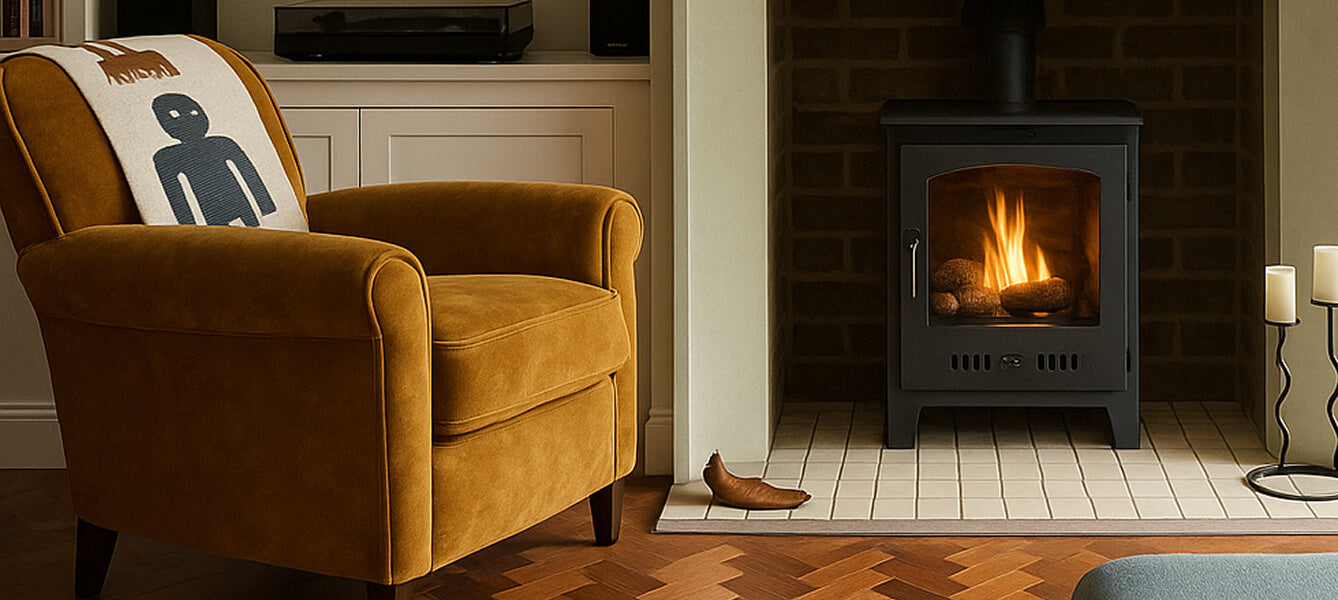No one wants to be cold this winter, but with the seemingly exponential rise in heating costs, many of us don’t have a choice.
However, there is a range of living room heating ideas that could change everything.
And when gas and electric costs are skyrocketing, perhaps it’s time to think outside of the box a little.
Don't be cold this winter. Consider how you might warm up your living room in different ways. Read on for helpful hints, tips, ideas and hacks to keep your living room toasty all winter.

How to warm up your living room?
If there's one thing this last couple of years has proven, it's how expensive it is to run gas central heating. And despite the hike in electricity costs per kWh, running the gas boiler is by far the most costly portion of the power bill.
And while we’re not necessarily advocating using electricity to heat your home, it’s been surprising that the impact of running an oil-filled radiator on home power bills has been minimal.
If you’ve been keeping a close eye on your power bills since the price hike, you’ll have been shocked by the cost of gas — at least £8-£10 a day to run it at just 19ºC.
Heating an awkward living space
Some rooms, like attics and sheds, don’t have access to the central heating system. Therefore, the most obvious choice is to rely on electric heating if you use these spaces for working or as a snug. But you have to be careful because running electric heaters can be cripplingly expensive.
We’ve found that convector heaters can cost a fortune to run, while far-infrared heaters can offer a cheap way to warm a room, but they’re not always brilliantly effective.
Also, oil-filled radiators offer the most economical electrical heating, costing around £1 a day to run (if you’re heating from 9-to-5). And while that still feels high, it’s relatively reasonable in comparison with gas central heating.
Of course, the greener alternative to heating an unheated living space is bioethanol. Read on for more information about this more environmentally-responsible way of warming a room.
How to warm up a large living room?
You probably only use your living room in the evenings during the week, although you’re likely to use it for longer over the weekends.
Most of us watch the TV, and leave the room to boil the kettle or go to the loo during ad breaks. So, is it worth heating the entire house when you spend 90% of the time in the living room?
Bearing in mind the costs of running gas central heating right now, a space heater could be the best alternative. Of course, a space heater only heats one room, but there are benefits to this.

Feeling the benefit of the warmth
When you’re sitting in a warmed room, your body will soon acclimatise and, eventually, you start to feel cold, which often means turning the heating up even further.
But if you heat one room, then step out into the cooler kitchen or loo, you feel the benefit of the warmth once again when you return to the living room.
This is a simple hack that can save a fortune on heating costs.
But what is the best space heater?
Which heater is best for living rooms?
Most of us have relied on radiators fed from a hot-water central heating system or an electric-powered warm air system to warm our living rooms. But that’s too expensive for many people at the moment.
Space heaters are a good alternative heating solution. However, choosing the right space heater is critical because some can cost you just as much (if not more) than your central heating system.
We’re going to look at:
- Heated blankets
- Bioethanol fireplaces
- Far infrared panel heaters
Heat yourself, not your living room
One particular tact that has grown in popularity is the idea of keeping yourself warm rather than heating the entire room. After all, heat rises to the ceiling before it reaches sitting level, so there's a lot of sense in more localised heating.
Apart from wearing lots of thin layers, which can help you regulate your body temperature, you can use a heated blanket or even a heated "Slanket" (a blanket with sleeves that you wear).
While these rely on electricity, some cost as little as 1p per hour to run, although some cost up to 5p an hour. Still, pretty affordable in comparison to heating the whole home.

Bioethanol fuel to heat your living room
Bioethanol fuel is a green eco-fuel that won’t pollute the air or contribute to global warming because it doesn’t create harmful emissions, unlike wood and coal burning.
Bioethanol is basically pure alcohol (but don’t drink it!), formulated from the by-products of crops such as corn and sugarcane.
But the best thing about burning bioethanol is that you don’t need a chimney or flue, making it the perfect living room space heater, regardless of the type of property you live in.
It’s easy to get hold of bioethanol online, but we recommend going for high-quality bioethanol fuel for a cleaner and longer burn.

How much does bioethanol cost (and is it economical)?
You can buy bioethanol for as little as £3 per litre, but it's essential to always go for high quality because cheaper ethanol may burn out more quickly.
And while burning bioethanol is more expensive than running a heated blanket, it does heat the entire living room with a lovely, cosy warmth that will keep you nice and toasty.
Far-infrared heaters for your living room
Far-infrared heaters are pretty new to the UK, but they're a reasonably cost-effective way to warm your living room electrically.
Far-infrared heaters produce safe rays that warm surfaces rather than the air. Think about the heat you feel when you sit in direct sun, which you avoid when you sit in the shade — that’s the same as far-infrared.
This technology sends gentle warming rays that heat surfaces such as tables, floors, sofas, and your skin — just like sitting in the sun on a chilly day still warms your skin, even if there's a breeze. But there are no harmful UV rays that can damage your skin — far infrared is safe for heating in the home.
However, you run far-infrared heaters almost constantly as they emit a gentle heat that accumulates over time. You can fit infrared heaters on the ceiling or the wall, and they'll heat everything directly in front of them.
And the heat level isn't affected by drafts, so these are a good solution for draughty living rooms.
How much power does a far-infrared heater use?
While far-infrared heaters use electricity, they use less than a traditional living room space heater.
For example, a 300W far-infrared heating panel will warm a 10m2 room sufficiently, while a 300W convection heater is unlikely to make much of an impact. If you want warmth from an electric space heater, you need wattage, with most requiring at least 1500W.
However, the current average cost of a kWh of electricity is around 32p. Hence, running a 1500W heater costs a staggering 48p per hour — that's £3.84 for an 8-hour run (for one room's heat).
In comparison, a far-infrared heater costs around 10p an hour to run. And while it takes longer to warm up a room with far infrared, it would cost £2.40 for the whole 24-hour period, which is much cheaper than a traditional electric space heater.
How will you heat your living room in winter?
We hope we've offered some interesting alternatives and solutions for living room heating ideas.
Because when we're so at the mercy of a volatile energy market, it's reassuring to know that there are genuine green alternatives, such as bioethanol and far infrared.
Get a stylish wood-burner style, freestanding, wall-mounted, or freestanding bioethanol fireplace. Or consider investing in an affordable far-infrared heater for warmth without the existential guilt (or high energy bills!).

Thanks for reading!

